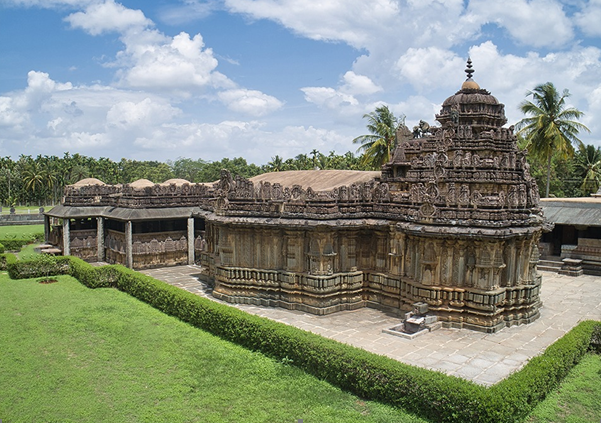Chikkamagaluru
The Archaeological Survey of India (ASI) brought the spotlight to the Amritesvara Temple in Amruthapura, a serene village nestled in the verdant landscapes of Chikkamagaluru district, Karnataka. Through a post on social media platform X, ASI showcased this 12th-century marvel, highlighting its historical significance, architectural brilliance, and cultural richness.
As Chikkamagaluru continues to captivate visitors with its coffee plantations, misty hills, and historical treasures, the Amritesvara Temple stands as a testament to the region’s glorious past under the Hoysala Empire.
The Amritesvara Temple was commissioned in 1196 CE by Hoysala general AmitayyaDandanayaka during the reign of King Ballala II (1173–1220 CE). Located approximately 67 kilometers north of Chikkamagaluru town, this temple is a compact yet elegant ekakuta (single-shrined) structure that reflects the traditional Hoysala layout.
Facing east, it features a garbhagriha (sanctum), antarala (vestibule), navaranga (closed hall), and mukhamandapas (entrance porches) on the south and east. The eastern mukhamandapa extends into a multi-pillared sabhamandapa, the temple’s most ornate section, adorned with intricate carvings that narrate tales from the Ramayana, Mahabharata, and Bhagavata.
The temple’s construction in black soapstone, a material favored by Hoysala artisans, showcases circular carvings on its exterior walls. A solitary tower rises above the sanctum, complemented by a wide open mandapa featuring 140 panels depicting Hindu mythological stories. The site’s proximity to the Bhadra River reservoir adds to its tranquil ambiance, making it a hidden gem amid Chikkamagaluru’s lush Western Ghats terrain.
The Amritesvara Temple is a fine example of Vesara-style architecture, a blend of Dravidian and Nagara styles prevalent during the Hoysala period. The superstructure above the garbhagriha is of the dvitala (two-tiered) design, crowned with a stupishikhara and a finial. The mahanasa of the sukanasi (tower over the vestibule) proudly displays an image of Shiva as Gajasuramardana (the slayer of the elephant demon), while the Hoysala royal emblem of Sala slaying the lion graces the gable above, symbolizing the dynasty’s valor.
The sabhamandapa is a highlight, featuring a kakshasana (peripheral seating bench) and 28 intricately decorated ceilings adorned with elaborate floral motifs. These ceilings are not just architectural feats but also historical records, bearing inscriptions that identify the sculptors—names like Mallitamma, Baluga, and Malaya stand out, reflecting the collaborative genius of medieval Karnataka artisans.
To the south, a shrine dedicated to Goddess Sarasvati stands as one of the finest representations of Hoysala art, adding to the temple’s spiritual and aesthetic appeal.
Beyond its architecture, the Amritesvara Temple is a repository of literary heritage. A notable Kannada inscription dated 1196 CE, found within the temple, was composed by the celebrated court poet KaviChakravarti Janna.
Janna, a prominent figure in medieval Kannada literature, contributed significantly to the cultural vibrancy of the Hoysala court, where architecture, poetry, and devotion intertwined. This inscription not only dates the temple but also connects it to a rich tradition of literary patronage in Chikkamagaluru’s historical landscape.
The ASI’s recent feature on X, complete with stunning aerial images, underscores its commitment to preserving and promoting India’s heritage sites. The images reveal the temple’s symmetrical layout, surrounded by lush greenery and palm trees, with traditional tiled-roof houses adding a rustic charm.
Situated about 50 kilometers from Shivamogga and 110 kilometers from Hassan, the Amritesvara Temple is easily accessible for those exploring Chikkamagaluru’s cultural and natural wonders. Its isolation amid the district’s rolling hills and coffee estates offers a peaceful retreat, contrasting with the bustling tourist hubs like Mullayanagiri or Baba Budangiri.
The temple’s dedication to Lord Shiva, combined with its artistic excellence, makes it a must-visit for history enthusiasts, architects, and spiritual seekers alike.Whether you’re drawn by the Hoysala craftsmanship, the literary inscriptions, or the serene surroundings, this temple invites you to step back in time and marvel at a masterpiece that has withstood nearly a millennium.



